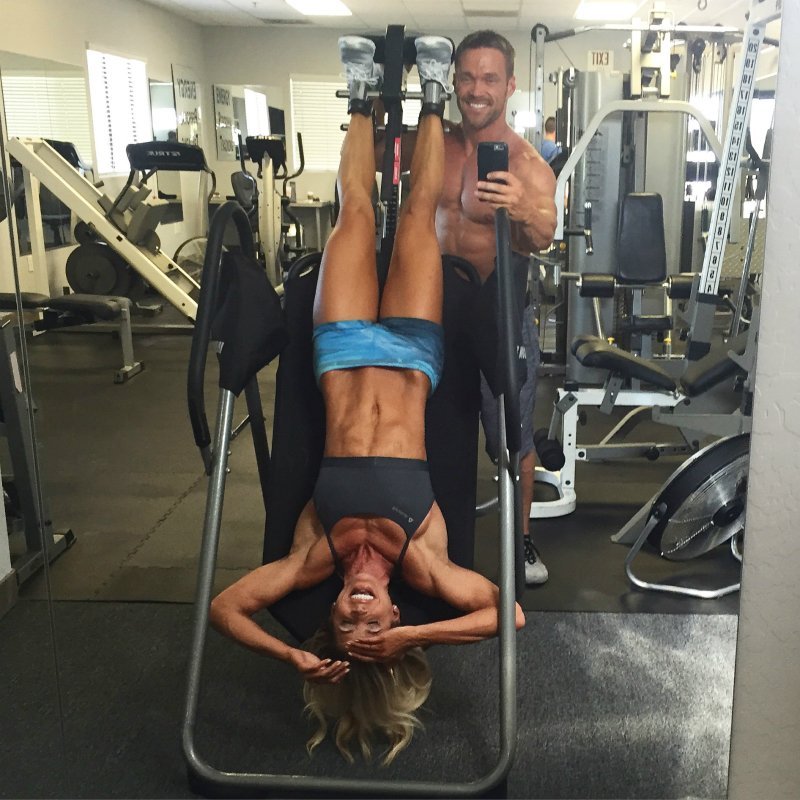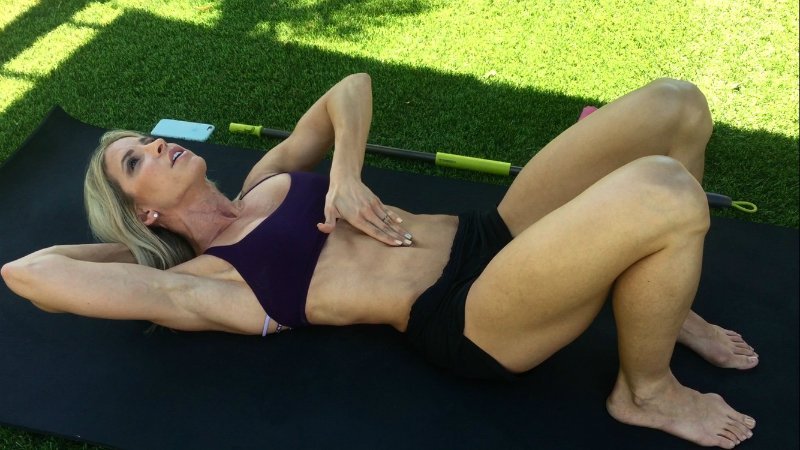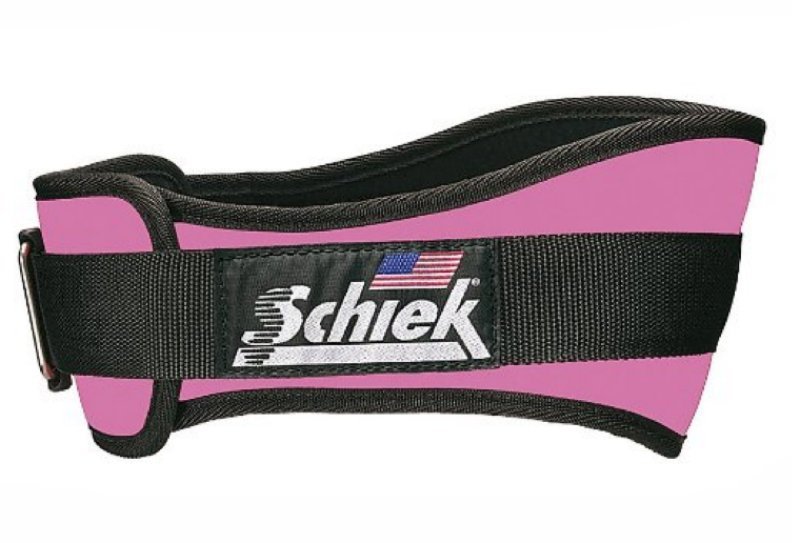Ok, here it is! Girl to girl, we need to discuss something I THINK is more common than I’ve ever believed! I’m getting a little personal and a little science-y on you today to talk about diastasis recti. Diastasis rect-who? Rect-ME! (Ok, stop).
I’m going to warn you up front. There is SO much to cover in this post—it’s a little long. If you wanna’ get straight to the meat (or the exercises you can do to fix your diastasis recti), scroll down. If you wanna’ learn more and figure out if you have this condition, keep reading.
Let me get you up to speed. Diastasis recti generally happens during pregnancy when the two large parallel bands of abdominal muscles separate due to the expanding uterus. Some women’s ab muscles go back to normal after the baby is born, and some do not…mine never have, and chances are yours haven’t either—which is why you are here.
The good news is that the diastasis caused by pregnancy can be corrected with exercises and stretches designed to optimize deep core muscular function. So ladies, don’t worry—your body wants to function right, and it will. We just need to wake up the right core muscles and teach them what to do! But let’s not get ahead of ourselves. Saving that for later.
Now how this happens and why it is worse for some women, no one is 100% sure. But we can hypothesize. It’s been said to be hereditary, but it may also be caused by working out your abs too soon after a baby is born, or even doing the wrong exercises WHILE pregnant. While I didn’t workout during ALL of my pregnancies (just the last 2), I personally feel like working my abs hard during prego worsened my condition. But that’s just my opinion.
Crazy fact, I didn’t even notice my ab separation until after Cash was born!! Yes, 3 kids later. I mean, I knew it was there, but I didn’t realize it was a medical condition. Embarrassingly enough, I always just thought I had definition down the center of my abs! Ha! Nope…wishful thinking. Just diastasis. Once I realized this odd look my midsection had wasn’t normal, nor was it normal for me to be able to literally stick my hand inside of my abs and touch my insides with just skin separating, I knew I had to do something about it. If you’d like a visual, just check out the pic below. This was posted on social media a couple of weeks back, and I got an overwhelming response from women (you!) that suffer from the same condition…
From a medical standpoint, until recently, I had a little over a 3-finger sized gap between my abs that was physically unprotected. Like I said, intestines…right below my skin. And during certain ab exercises, my insides would actually protrude through my abs, forming a weird point. Disgusting, I know. And it’s even scarier to think how vulnerable my vital organs were. If this went untreated, I could suffer from a major intestinal hernia, and given my level of activity (and types of heavy lifting), chances of this happening are higher than most. I mean, I already have an obvious umbilical hernia (my dramatic outtie belly button) so I figure I am more prone than most…
Extensive research on the topic taught me a few things…one of them being there are a handful of factors that make a woman more susceptible to diastasis recti:
- Having more than one child/pregnancy
- Having pregnancies close together
- Being?over the age of 35
- Having big babies
- Having multiple births
I know…some of you are looking at this ist realizing you’ve been double—or even quadruple—whammied! (I?m raising my hand to a couple). Don?t beat yourself up about what you cannot change because diastasis recti is very common—about 67% of all postpartum women have it. So you (and I) are in good company.
If you’re not sure if you are among the lucky few who steered clear of this pregnancy consequence, here’s an easy way to check:
- Lie on your back with your knees bent, soles of your feet close to your booty.
- Place one hand behind your neck and the other hand on your abdomen with your fingertips flat at your belly button, fingers facing downward.
- Gently push your fingertips into your abdomen while rolling your upper body off of the floor, chin towards the ceiling.
- Feel for a separation between those two ab muscles. Experts say that a 2-2.5 finger or more spread signals diastasis recti.
Now, let’s talk about our options moving forward. We can go the immediate and potentially easy (but expensive) route with surgery. BUT, surgery is not always recommended if you are still in your childbearing years…I mean think about it, one more baby, and you’ll pop those abs right back apart! As well, there is no guarantee that surgery will be 100% effective. (SIDE NOTE…Research on this topic started once Chris told me NO to this option because he wants more babies! Another topic for another day…but…).
So for me, at-home exercises and remedies are the way to go. Anytime I can avoid going under the knife, I will. And worst case? If the exercises don’t work, surgery as an option is always going to be there.
Before we go farther—a very important disclaimer: The following “fixes” are all based on my experience and my research, so please check with your doc BEFORE doing anything for your diastasis recti since each case is different. Okay, here goes:
Over this past year, my training protocol has changed as I have transitioned from CrossFit-style workouts to body building. Along with the training change-up, I changed the way I worked my abs too, focusing on decreasing (actually eliminating) the typical ab exercises and increasing the deep-core muscle exercises. I am happy to report that over this year, my abdominal muscle separation has decreased dramatically to less than 2 fingers!! But it still isn’t quite where I need it to be to consider myself healed.
The proof is in the pudding for me: A lot of this boils down to doing the RIGHT exercises. I realize that for so long I was doing what I intuitively thought would work (swing ups, sit ups, V ups, knees to bar, etc), but in reality, these move were working against me by ONLY working my Rectus Abdominus. The REAL muscles that needed working are known as the Transversus Abdominus and Lumbar Multifidus. These are the the most neglected of the ab muscles, but also happen to be arguably the most important. They lie beneath the Rectus Abdominus, supporting posture, controlling breathing during heavy lifts, and supporting the back. These are the muscles elite athletes work to add explosive power to training and are also the muscles we mamas need to work to relieve back pain, create a tighter midsection, AND improve our diastasis recti.
Some at-home exercises you can do to focus on these important muscles are below. I’ve also recorded a demonstration video for you (at the bottom of the post) so you can SEE how to perform these moves right and hear my instructions. Make sure that when you do these moves, you focus and move slowly—keeping the mind body connection. In other words, don’t just go through the moves. You’ll notice that breathing is a KEY component to all of these movements: Deep inhales, and exhale when you activate the muscles.
-
- Drawing In Exercise: Now technically every single move listed below requires you to “draw in,” so I figured I would do a little explaining. Drawing in is NOT sucking in (which uses the outer muscles). Drawing in is done by allowing those inner muscles to pull your abdomen deep inside toward your spine. Draw in from the lower region of your abs. Drawing in is something you can do in sets for as long as you can hold (work up to 60 seconds at a time), or it’s something you can simply do as you walk around your house. Believe it or not, your posture will improve big time with this! This can be done standing, sitting, lying down…you name it. Just DRAW IN!
- Vacuuming: No…not vacuuming your carpet (although I guess technically you can vacuum ON your carpet). I’m talking about the core exercise known by this name. I know I’ve talked about this before, but I’m going to talk about it again. Easily explained, simply stand up straight, inhale deeply, followed by an exhale. Once all of the air is deflated from your lungs, draw your belly button in and up toward your spine. HOLD (as tough as it is) for as long as you can. I aim for 30 seconds, but if holding your breath that long isn’t doable, simply keep the clock running and keep your belly button in and tight as you slowly breathe for the remainder of the 30 seconds. Try for 5-10 reps a day.
- Broomstick Rotations: With a dowel or a broomstick behind your neck, perform a vacuum, then when all air is exhaled and you are holding your breath with your abs squeezed, slowly rotate from side to side until you cannot hold your breath any longer. Breathe. Repeat 5-10 times.
- Abduction with Core Activation: Lie on your back with a resistance band around your knees. Exhale, engage your core and pelvic floor and pull your knees apart. Relax, inhale, and repeat for 10 reps. Be sure to keep your spine neutral and don’t press your lower back into the ground.
- Heel Slide: Lie on your back with both knees bent, feet flat. Exhale as you engage your core and pelvic floor, and slide one heel slowly along the ground until your leg is straight. Inhale and relax, then engage your core, exhale, and draw that heel back. Do 5 reps on each leg.
Once again, scroll to the bottom for my step-by-step video.
Now when it comes to traditional training and weight lifting, consider wearing a weight belt. It has worked WONDERS for me. Not only will a weight belt support your core while lifting heavy loads, but more importantly, it will act as a cue/reminder to activate and draw in with your core while lifting. Otherwise, we are naturally prone to distending our bellies during heavy lifting, only worsening our diastasis recti. This is the one I use…
So ladies, however you choose to take care of your diastasis recti, whether DIY exercises or surgery, know you are making the choice that is right for you! It’s a medical condition and not just a vain aesthetic concern, so if surgery is what you choose, then surgery it is! But if exercises are your method of healing, please keep me up to speed on your progress.
And in the meantime, have those babies, LOVE those babies, and appreciate every consequence of having such perfect little miracles! #BattleWounds
And finally…the demonstration vid…;)
Xoxo,
Heidi
Related reading:
Ask Heidi Anything: Carb Cycling While Prego?
My 1st Post Ruby Workout
My Pregnancy Workout: The Nasty 9s
My 5 Gym (and Home Gym) Must-Haves






262 Responses
Hello! I just wanted to post from a different perspective. 🙂
I was one of the unlucky few after childbirth where the gap didn’t close at all. Mostly due to heredity, I’m guessing. Weight was lost and I was very fit. But… the gap didn’t close and I was suffering from other issues as well (incontinence, prolapse and the general feeling that my intestines were just about outside my body).
I finally consulted several doctors, and after years of deliberation after two babies, I made the decision to close the gap surgically for my own health. I’ve healed well so far, and despite the fact that there are no guarantees, so far it’s been the right choice for me.
Exercise and self care are always a best bet!! But, I did want to point out that in the event that a woman turns to surgery, be sure to consult with surgeons who are board certified. It will save you unnecessary health risks and ensure you get the results that you desire! And then be willing to continue to self improve with the appropriate self care (diet and exercises) after. No better investment than your own body! 🙂
Happy to have stumbled on this article, even it if its a bit late! Now I have new exercises to use as I continue to heal from surgery!!
Hi heidi – thank you for this information. I am 44 year old man and just diagnosed with rectus diastasis after a second abdominal surgery – the second to repair a hernia and reconstruct my abdomin. I am hesitant to have another surgery for obvious reasons. Do your excercises work for men as well ?
Hi Jeff: Yes, they can work for both men and women, but please discuss any exercises with your healthcare team first and get their okay or modifications. We wish you all the best! 🙂
Hey there! I was wondering about how long these need to be done until the DR is healed? Or is everyone completely different? Thank you!
Hi Charity: Yes, each person is different. But you can actually do these exercises to keep your core strong even after your DR is healed! 🙂
Hello there…. thank you sooo much for the detailed information. I just found out I have diastasi recti (3 fingers separation). Baby is now 19 month old… So I’m starting to educate myself about it so I can start doing the right exercises to bring healing. I wanted to asked you will the flex belt / slendertone ( electric muscle stimulator) help alongside the exercises you talked about and a healthy diet?
Hi Dayana: Heidi doesn’t use this product, but I’d definitely ask your healthcare team what they think about using it. Happy DR healing! 🙂
I just had my second baby (five years after my first) 4 weeks ago. Last night I did the “test” and felt a two finger separation! I’m bummed. So, is it actually possible to close/repair the diastasis recti? Should I wait 6 weeks before doing these exercises? Is there ever going to come a time when doing regular abdominal exercises is ok? If so, how will I know when? Also, what should I try if I am having trouble finding/feeling the pelvic floor? Thank you SO MUCH!
Hi Gladys: Congratulations on your new baby! I’d definitely discuss this with your healthcare team at your next appointment and then follow their recommendations. Since what is best for one woman could be not so good for another, they will be able to help you find the answers to these questions that will work best for you. We wish you all the best! 🙂
Thanks so much for this! I have 3 kids and I?m currently pregnant with #4. I had diastasis recti pretty bad after my now 6 year old was born, but back then I did not really know what was going on with my stomach. I am very active, but I want to try and avoid getting a huge gap this time around.
This was so helpful and informative to me. I am a 5 ft 1 small person with a tall husband and had a large baby. My belly button is no longer an innie and I thought it was just destined to look strange but when I saw the way yours looks it gave me hope. I?m still working on it but have seen lots of improvements before seeing this I didn?t think the gap would ever really close. So thank you!
Thank you for posting this, Heidi! I had twins almost a year ago and still have a belly protrusion and about a 1.5/2 finger gap but it is so much better after doing the exercises you mentioned above. I really appreciate you! ?? Thanks, again!
Tiffani Westbrook
hello, can you close the gap while you have a small umbilical heria
Hi I was wondering if you ever got an answer anywhere on this?
Hi Christy: With any sort of diastasis recti and/or hernia issue, it’s really best to follow your doctor’s recommendations as far as any treatment. Each woman’s issue can be different, which requires a different treatment. I hope that helps! 🙂
Hi Ashleigh: I sincerely apologize! Some how your question got lost in all of our comments. With any diastasis recti and/or hernia issues, it’s best to work with your healthcare team on what is best for you treatment-wise. What works for one woman can be the totally wrong thing for another, and we’d hate to recommend something that wouldn’t work for you. 🙂
I was wondering if it was possible to treat platysmal band diastasis in the neck with exercises too? I’m in my forties and really don’t want a neck lift. My neck band muscles have seperated with aging. Some people never get this. Are there any core exercises for neck?
Hi Kristy: Thank you for your comment! 🙂 I’d definitely discuss this with your healthcare team and then follow their recommendations. They are the best ones to help you since they can work with you personally and since what would be correct for one person might not be the best course of treatment for another. We wish you all the best! 🙂
I want to know this too
I am a mother of four children, my first baby was completely natural but my second child and my twins where C-section and I’m not sure what that diastasis recti is or exactly what it may look like but if there would be some way for me to contact you so I could send you a picture maybe you could tell me if it looks like it
Hi Mandi: It would be best for you to consult with your healthcare team to see if you have Diastasis Recti and for any treatment program if you do. We wish you all the best! 🙂
Mandi, look for a pelvic Physical Therapist in your area to complete a thorough exam and provide you with information and treatment specific to your body.